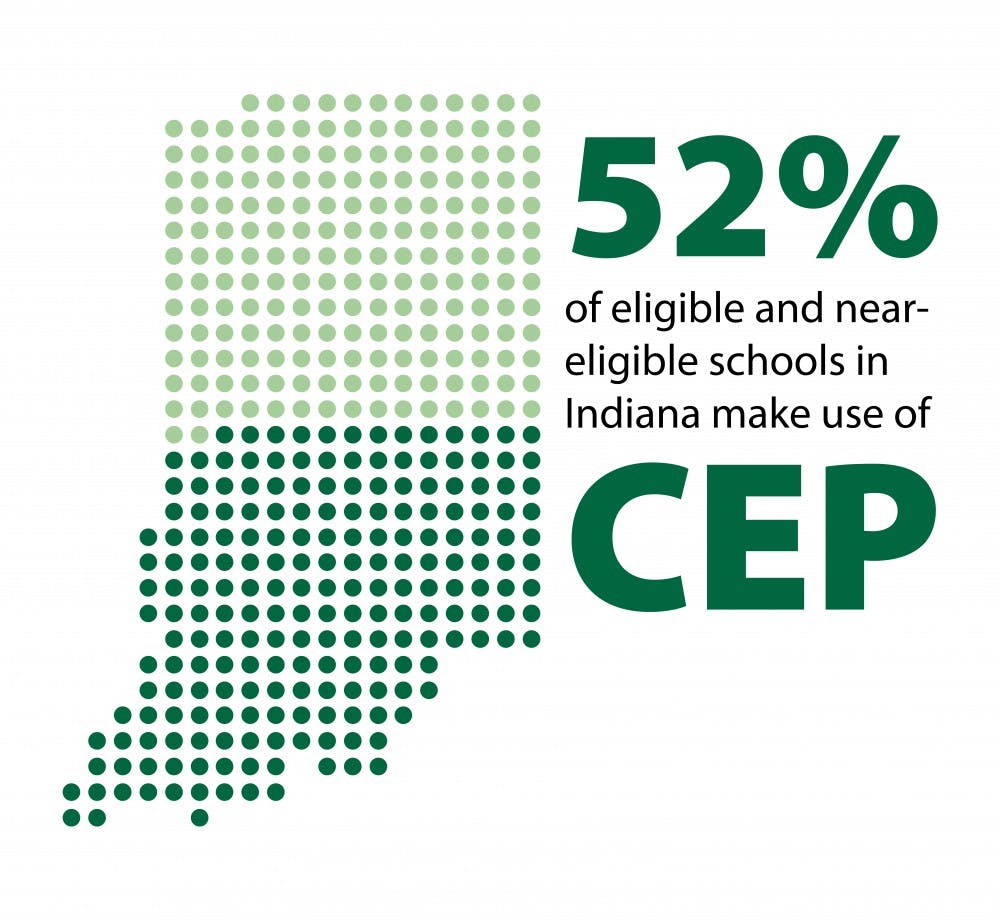Editor's Note: This story is part of The Partnership Project, a series of content written in an effort by The Daily News to follow the formal collaboration of Ball State University and Muncie Community Schools. Read more in this series here.
Ever since his stepdaughter got a pamphlet three years ago stating there would be free lunch and breakfast at Southside Middle School during the summer, David Wentz has been bringing her and her sister to the school’s cafeteria to make use of the program.
“Being on disability, it’s hard for me to make sure they get their meals throughout the day,” Wentz said. “We do dinners everyday but lunch is hard for me to get. So, with the community doing a free lunch, it kind of helps me out.”
Wentz is among many whose families make use of the annual Muncie Community Schools (MCS) free summer meals program which offers free breakfast and lunch for children at different locations with a $2 charge for adults.
When he was a kid, Wentz made use of a similar meals program run by Ross Community Center.
“If it wasn’t around back then I probably would’ve starved just because my dad didn’t make much money then,” he said. “We all walked up there and got our lunches throughout the day instead of just waiting on dinner.”
MCS Summer Meals:
The MCS Summer Meals program is run by Chartwells, a school food service company of Compass USA. Chartwells also runs the food service at MCS during the regular academic semesters.
With over 80 percent of students at MCS using the free and reduced lunch program during the regular school year, Stephanie Fegan, resident district manager of MCS who works for Chartwells, said it needed to “fill that gap nutritionally and educationally just to help them make healthier choices and simply just to give them something to eat over the summer.”
“It’s just the right thing to do,” Fegan said. “It’s something a lot of communities need, and especially in Muncie with our free and reduced lunch percentage, it just made perfect sense.”
Through educational programs like chef tables during the school year, MCS and Chartwells also help spread awareness on healthy nutrition, she said.
“I think there are a lot of great local places a lot of good healthy options but I just don’t think a lot of people are aware of it, especially children,” she said. “I think you have to teach them to make those healthy choices, to recognize those kinds of foods and the parents as well.”
Community Eligibility Provision:
MCS will be moving away from the free and reduced lunch program to the Community Eligibility Provision (CEP) in the fall which will offer all enrolled students breakfast and lunch at no cost.
According to the Indiana Department of Education’s (IDOE) website, for a local educational agency (LEA) to be eligible to use CEP for the 2019-20 school year, “the LEA must have one or more school having an identified student percentage of 40% or greater as of April 1, 2019.”
The Food Research & Action Center’s Community Eligibility Database of eligible and participating Schools in the 2018-19 school year, five out of nine schools in MCS had an identified student percentage (ISP) greater than 40 percent.

The database also states that in Indiana 362 schools adopted CEP out of 701 eligible and near-eligible schools.
“When we looked at Muncie it just made perfect sense to do that because we do meet those qualifications and the need is definitely here,” Fegan said.
She said students will benefit from eating meals for free without having to worry about filling free and reduced applications or having no funds in their accounts.
Fegan also said the program was “not a financial burden but rather a benefit to the district” with the district being reimbursed at a certain rate for every child that eats.
IDOE’s website states that federal reimbursement for schools participating in CEP is based on claiming percentages derived from the percentages of identified students multiplied by a USDA established factor (currently 1.6). The LEA and the school is required to cover any cost above the federal reimbursement received with non-federal funds.
It also states “CEP is approved for four successive school years, with an option annually to return to traditional meal counting and claiming procedures.”
“It’s definitely financially responsible, morally responsible for the children,” Fegan said. “It’s a win win for everybody.”

Nutrition:
Jayanthi Kandiah, interim chair of the department of nutrition and health science, said it’s important to contribute to the “building of healthy foundation for this young generation.”
“The sooner we start, the better, because during the formative and impressionable years it’s always easier to encourage them to eat healthily or to try a variety of foods,” Kandiah said.
She said obesity could result in physical, social and emotional complications in children when they become adults.
She also pointed out the economic cost of obesity to the general population. According to the Centers for Disease Control and Prevention’s website the medical care costs of obesity in the United States were estimated to be $147 billion in 2008 dollars. It also states that the annual nationwide productive costs of obesity-related absenteeism range between $3.38 billion and $6.38 billion.
Kandiah said multiple factors were responsible for obesity among school-age children including family history, behavioral lifestyles, environment, culture, biological issues, medical illnesses, etc. but the most common factor is poor dietary habits.
While the National School Lunch Program (NSLP) is administered at the federal level by the Food and Nutrition Services of the United States Department of Agriculture, decision on what foods to serve and how the food is made is done by local school authorities, she said.
All schools still have to meet the recommended dietary allowances as directed by the FNS. She said the school lunch program meets one-third of a student’s recommended daily caloric and nutrient intake while the school breakfast program accounts for one-fourth.
Children who have school breakfast and lunch meals have better diet quality, perform better on standardized tests and improved attendance, behavior and academic performance than those who skip breakfast, Kandiah said.
She said having both breakfast and lunch eliminated the disparity between food secure and food insecure children.
“Overall, in my opinion, I think it’s a great idea, it’s a wonderful idea, it will benefit the children,” Kandiah said. “If children don’t get the meals they’re not going to be performing well.”
Community:
Fegan said Chartwells satellites food to 11 sites including local libraries, camps and other locations. It is also looking into the process of farm to schools for the coming school year.
“We have really great community partners,” Fegan said. “There’s always opportunity for growth and reaching out and making those connections and hopefully it’ll just keep growing.”
Local organizations like the Boys & Girls Club (BGC) of Muncie which operates in Southside Middle School during the summer also take advantage of the Summer Meals program.
Clemens said the food served through the summer meals program have all the components needed for BGC’s 325 enrolled students in the summer program “to continue to grow and become strong healthy adults.”
She said apart from food, Chartwells also provides them with packed meals for field trips, utensils and staffing when needed.
“Everyone is so nice and welcoming here,” Clemens said. “Not only are they getting a warm meal here, but they’re getting a warm smile and we appreciate that so much.”
Fegan said Chartwells’ programs are about “appealing to the whole student” and “not just feeding them.”
“We’re really excited to be part of the process to just do the right thing for the students,” she said. “It’s just wanting to be part of doing what’s right for the community, for the whole child, for the whole family.”
Contact Rohith Rao with comments at rprao@bsu.edu or on Twitter @RaoReports. Contact Jake Merkel with comments at jamerkel@bsu.edu.





